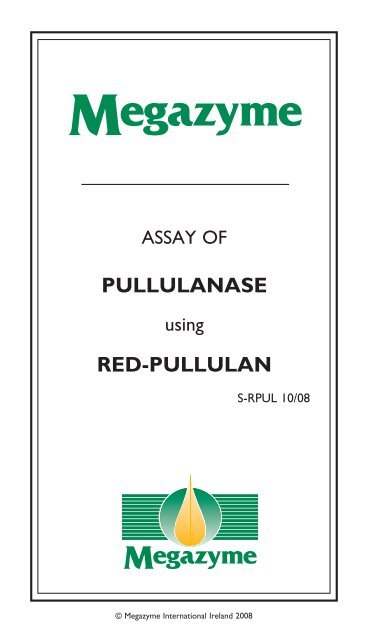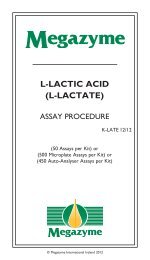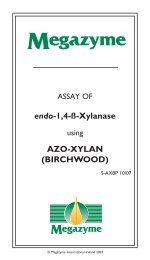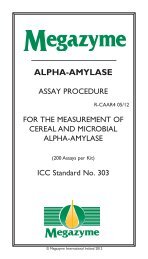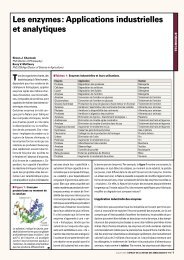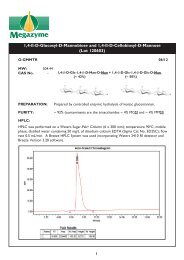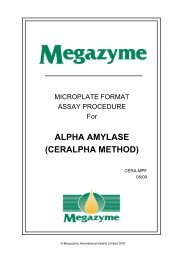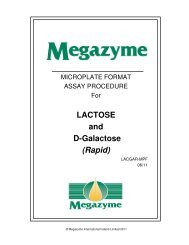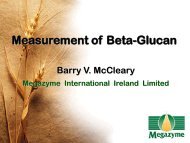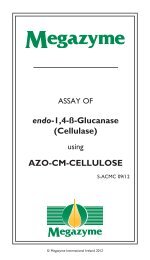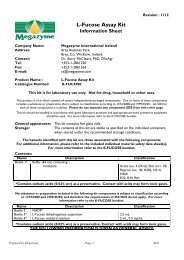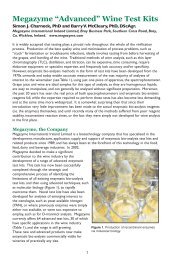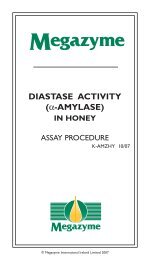PULLULANASE RED-PULLULAN - Megazyme
PULLULANASE RED-PULLULAN - Megazyme
PULLULANASE RED-PULLULAN - Megazyme
You also want an ePaper? Increase the reach of your titles
YUMPU automatically turns print PDFs into web optimized ePapers that Google loves.
ASSAY OF<br />
<strong><strong>PULLULAN</strong>ASE</strong><br />
using<br />
<strong>RED</strong>-<strong>PULLULAN</strong><br />
S-RPUL 10/08<br />
© <strong>Megazyme</strong> International Ireland 2008
PRINCIPLE:<br />
This assay procedure is specific for endo-acting pullulanase<br />
and limit-dextrinase (from grain) activity. On incubation of<br />
Red-Pullulan with pullulanase or limit-dextrinase the substrate<br />
is depolymerised by an endo-mechanism to produce lowmolecular-weight<br />
dyed fragments which remain in solution on<br />
addition of ethanol to the reaction mixture. High-molecular<br />
weight material is removed by centrifugation, and the colour<br />
of the supernatant is measured at 510 nm. Pullulanase in the<br />
assay solution is determined by reference to a standard curve.<br />
Although this substrate can be used to measure limit-dextrinase,<br />
we recommend the use of Limit-Dextrizyme tablets<br />
(cat. no. T-LDZ) which form the basis of an assay with a greater<br />
sensitivity.<br />
SUBSTRATE:<br />
The substrate is partially depolymerised pullulan which is dyed<br />
with Procion Red MX-5B to an extent of approx. one dye<br />
molecule per 30 sugar residues.<br />
Add 0.5 g of powdered substrate to 25 mL of 0.5 M potassium<br />
chloride solution and stir vigorously at room temperature until it<br />
completely dissolves.<br />
This substrate is not stable at room temperature for extended<br />
periods, and thus should be stored at 4°C between use. For long<br />
term storage, it is recommended that the substrate be stored in<br />
a well sealed glass bottle and be overlain with a few drops of<br />
toluene to prevent microbial growth.<br />
BUFFER SOLUTION:<br />
(Sodium Acetate buffer, 200 mM, pH 5.0)<br />
Add 12.0 g of glacial acetic acid (1.05 g/mL) to 800 mL of distilled<br />
water. Adjust the pH to 5.0 by the addition of 5 M (20 g/100 mL)<br />
sodium hydroxide solution. Approximately 100 mL is required.<br />
Adjust the volume to 1 litre.<br />
ENZYME PREPARATION:<br />
Add 1.0 g of powdered enzyme preparation or 1.0 mL of liquid<br />
enzyme preparation to 90 mL of 200 mM sodium acetate buffer<br />
(pH 5.0) in a 100 mL volumetric flask and adjust the volume to<br />
100 mL. Add a magnetic stirrer bar and gently stir the solution/<br />
slurry at room temperature over 15 min. Filter an aliquot of<br />
the solution, if necessary, and dilute further in 200 mM sodium<br />
acetate buffer (pH 5.0), as required to obtain the correct<br />
concentration for assay.<br />
1
ASSAY PROCEDURE:<br />
Pre-equilibrate enzyme solution at 40°C for 5 min.<br />
Add 1.0 mL of pre-equilibrated enzyme solution to 0.5 mL of<br />
pre-equilibrated Red Pullulan solution. Stir the mixture and<br />
incubate at 40°C for exactly 10 min.<br />
Terminate the reaction and precipitate high-molecular weight<br />
substrate by the addition of 2.5 mL of ethanol (95% v/v)<br />
[or industrial methylated spirits (IMS, 95% v/v)] with vigorous<br />
stirring for 10 sec on a vortex mixer. Allow the reaction tubes<br />
to equilibrate at room temperature for 10 min. Centrifuge tubes<br />
at 1,000 g for 10 min.<br />
Pour the supernatant solution directly from the centrifuge tube<br />
into a spectrophotometer cuvette and measure the absorbance<br />
of blank and reaction solutions at 510 nm against distilled water.<br />
Activity is determined by reference to a standard curve.<br />
The blank is prepared by adding ethanol to the Red-Pullulan<br />
substrate before addition of the enzyme. Usually, a single blank<br />
is required with each set of determinations.<br />
STANDARD CURVE:<br />
Standard curves for pure Bacillus acidopullulyticus pullulanase,<br />
Bacillus licheniformis pullulanase and Klebsiella planticola pullulanases<br />
on Red Pullulan (Lot 61201) are shown in Figs. 1-3, respectively.<br />
Enzyme activity is standardised using borohydride reduced<br />
pullulan (1.0% w/v) as substrate in 100 mM sodium acetate<br />
buffer (pH 5.0) at 40°C using the Nelson/Somogyi reducing sugar<br />
method.<br />
One Unit of activity is defined as the amount of enzyme<br />
required to release one μmole of D-glucose reducingsugar<br />
equivalents per minute under the defined assay<br />
conditions (pH 5.0, 40°C).<br />
2
Pullulanase, milli-Units/mL (ie./assay)<br />
mUnits/mL = 360 x Abs + 11; R = 0.99<br />
Absorbance, 510 nm<br />
Figure. 1. Bacillus acidiopullyticus pullulanase on Red-Pullulan<br />
(Lot 61201).<br />
Absorbance, 510 nm<br />
Pullulanase, milli-Units/mL (ie./assay)<br />
Figure. 2. Bacillus licheniformis pullulanase on Red-Pullulan<br />
(Lot 61201).<br />
3
Pullulanase, milli-Units/mL (ie./assay)<br />
Absorbance, 510 nm<br />
Figure. 3. Klebsiella planticola pullanase on Red-Pullulan<br />
(Lot 61201).<br />
CALCULATIONS:<br />
Units/mL of original solution<br />
= milli-Units per assay (ie. per 1.0 mL) x 100 x 1 x Dilution.<br />
1000<br />
where:<br />
milli-Units per assay is determined by reference to the Standard<br />
Curve.<br />
100 = initial extraction or dilution volume<br />
(e.g. 1 g per 100 mL).<br />
1 = conversion from milli-Units to Units.<br />
1000<br />
Dilution = further dilution of the original enzyme extract.<br />
4
NOTES:<br />
5
NOTES:<br />
6
<strong>Megazyme</strong> International Ireland,<br />
Bray Business Park, Bray,<br />
Co. Wicklow,<br />
IRELAND.<br />
Telephone: (353.1) 286 1220<br />
Facsimile: (353.1) 286 1264<br />
Internet: www.megazyme.com<br />
E-Mail: info@megazyme.com<br />
WITHOUT GUARANTEE<br />
The information contained in this booklet is, to the best of our knowledge, true and accurate,<br />
but since the conditions of use are beyond our control, no warranty is given or is implied in<br />
respect of any recommendation or suggestions which may be made or that any use will not<br />
infringe any patents.<br />
7


